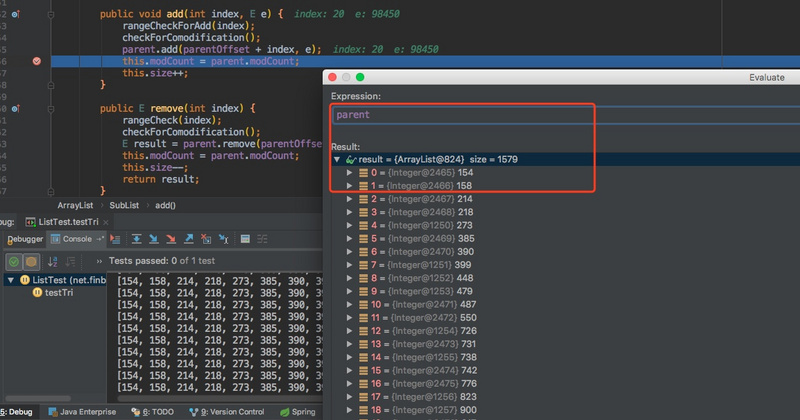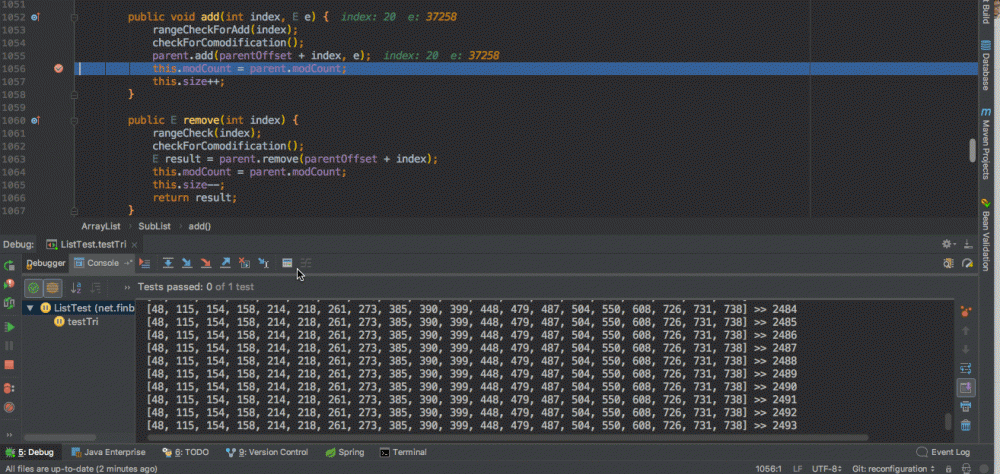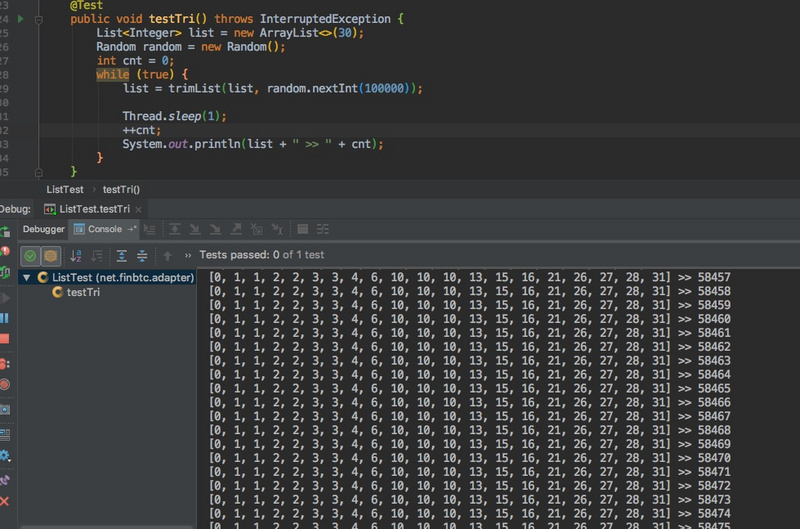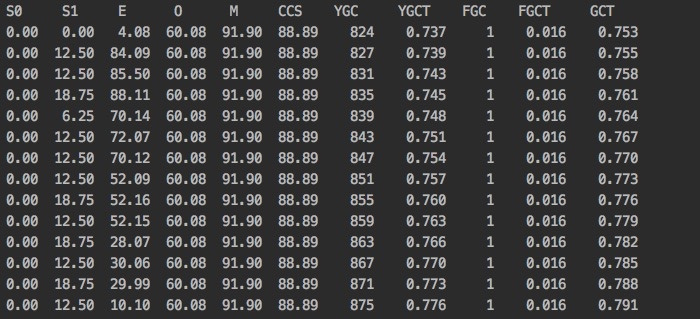老哥你真的知道ArrayList#sublist的正确用法么
我们有这么一个场景,给你一个列表,可以动态的新增,但是最终要求列表升序,要求长度小于20,可以怎么做?
这个还不简单,几行代码就可以了
public List<Integer> trimList(List<Integer> list, int add) {
list.add(add);
list.sort(null);
if (list.size() > 20) {
list = list.subList(0, 20);
}
return list;
}
<!-- more -->
1. 测试验证
上面的代码先不考虑性能的优化方面,有没有问题?
写了个简单的测试case,我们来看下会出现什么情况
@Test
public void testTri() throws InterruptedException {
List<Integer> list = new ArrayList<>(30);
Random random = new Random();
int cnt = 0;
while (true) {
list = trimList(list, random.nextInt(100000));
Thread.sleep(1);
++cnt;
System.out.println(list + " >> " + cnt);
}
}
启动参数修改下,添加jvm最大内存条件 -Xmx3m , 然后跑上面代码,一段时间之后居然出现 stack over flow

有意思的问题来了,从逻辑上看,这个数组固定长度为20,顶多有21条数据,怎么就会内存溢出呢?
2. SubList 方法揭秘
我们看下ArrayList#sublis方法的实现逻辑,就可以发现获取子列表,居然只是重置了一下内部数组的索引
public List<E> subList(int fromIndex, int toIndex) {
subListRangeCheck(fromIndex, toIndex, size);
return new SubList(this, 0, fromIndex, toIndex);
}
private class SubList extends AbstractList<E> implements RandomAccess {
private final AbstractList<E> parent;
private final int parentOffset;
private final int offset;
int size;
SubList(AbstractList<E> parent,
int offset, int fromIndex, int toIndex) {
this.parent = parent;
this.parentOffset = fromIndex;
this.offset = offset + fromIndex;
this.size = toIndex - fromIndex;
this.modCount = ArrayList.this.modCount;
}
...
}
返回的是一个SubList类型对象,这个对象和原来的List公用一个存储数据的数组,但是多了两个记录子列表起始的偏移;
然后再看下SubList的add方法,也是直接在原来的数组中新增数据,想到与原来的列表在指定位置插入数据
public void add(int index, E e) {
rangeCheckForAdd(index);
checkForComodification();
parent.add(parentOffset + index, e);
this.modCount = parent.modCount;
this.size++;
}
所以上面实现的代码中 list = list.subList(0, 20); 这一行,有内存泄露,貌似是只返回了一个20长度大小的列表,但是这个列表中的数组长度,可能远远不止20
为了验证上面的说法,debug下上面的测试用例

动图演示如下

3. 正确使用姿势
上面知道sublist并不会新创建一个列表,旧的数据依然还在,只是我们用不了而已,所以改动也很简单,根据sublist的结果创建一个新的数组就好了
public List<Integer> trimList(List<Integer> list, int add) {
list.add(add);
list.sort(null);
if (list.size() > 20) {
list = new ArrayList<>(list.subList(0, 20));
}
return list;
}
再次测试,代码一直在顺利的执行,看下后面的计数,都已经5w多,前面1w多久报错了

虽然上面解决了内存泄露,但是gc也很频繁了,本篇的重点主要是指出sublist的错误使用姿势,所以上面算法的优化就不详细展开了

4. 知识点扩展
看下下面的测试代码输出应该是什么
@ToString
public static class InnerC {
private String name;
private Integer id;
public InnerC(String name, Integer id) {
this.name = name;
this.id = id;
}
}
@Test
public void subList() {
List<Integer> list = new ArrayList<>();
for (int i = 0; i < 20; i++) {
list.add(i);
}
// case 1
List<Integer> sub = list.subList(10, 15);
sub.add(100);
System.out.println("list: " + list);
System.out.println("sub: " + sub);
// case 2
list.set(11, 200);
System.out.println("list: " + list);
System.out.println("sub: " + sub);
// case 3
list = new ArrayList<>(sub);
sub.set(0, 999);
System.out.println("list: " + list);
System.out.println("sub: " + sub);
// case 4
List<InnerC> cl = new ArrayList<>();
cl.add(new InnerC("a", 1));
cl.add(new InnerC("a2", 2));
cl.add(new InnerC("a3", 3));
cl.add(new InnerC("a4", 4));
List<InnerC> cl2 = new ArrayList<>(cl.subList(1, 3));
cl2.get(0).name = "a5";
cl2.get(0).id = 5;
System.out.println("list cl: " + cl);
System.out.println("list cl2: " + cl2);
}
再看具体的答案之前,先分析一下
针对case1/2,我们知道sublist返回的列表和原列表公用一个底层数组,所以这两个列表的增删,都是相互影响的
- case1 执行之后相当于在list数组的下标15这里,插入数据100
- case2 执行之后,list的下标11,相当于sub的下标1,也就是说sub[1] 变成了200
对于case3/4 而言,根据sub创建了一个新的列表,这个时候修改新的列表中的值,会影响到原来的列表中的值么?
分析这个场景,就需要看一下源码了
public ArrayList(Collection<? extends E> c) {
elementData = c.toArray();
if ((size = elementData.length) != 0) {
// c.toArray might (incorrectly) not return Object[] (see 6260652)
if (elementData.getClass() != Object[].class)
elementData = Arrays.copyOf(elementData, size, Object[].class);
} else {
// replace with empty array.
this.elementData = EMPTY_ELEMENTDATA;
}
}
// 对应的核心逻辑就在 Arrays.copyOf,而这个方法主要调用的是native方法`System.arraycopy`
public static <T,U> T[] copyOf(U[] original, int newLength, Class<? extends T[]> newType) {
@SuppressWarnings("unchecked")
T[] copy = ((Object)newType == (Object)Object[].class)
? (T[]) new Object[newLength]
: (T[]) Array.newInstance(newType.getComponentType(), newLength);
System.arraycopy(original, 0, copy, 0,
Math.min(original.length, newLength));
return copy;
}
从上面的源码分析,会不会相互影响就看这个数组拷贝是怎么实现的了(深拷贝?浅拷贝?)
接下来看下实际的输出结果
list: [0, 1, 2, 3, 4, 5, 6, 7, 8, 9, 10, 11, 12, 13, 14, 100, 15, 16, 17, 18, 19] sub: [10, 11, 12, 13, 14, 100] list: [0, 1, 2, 3, 4, 5, 6, 7, 8, 9, 10, 200, 12, 13, 14, 100, 15, 16, 17, 18, 19] sub: [10, 200, 12, 13, 14, 100] list: [10, 200, 12, 13, 14, 100] sub: [999, 200, 12, 13, 14, 100] list cl: [BasicTest.InnerC(name=a, id=1), BasicTest.InnerC(name=a5, id=5), BasicTest.InnerC(name=a3, id=3), BasicTest.InnerC(name=a4, id=4)] list cl2: [BasicTest.InnerC(name=a5, id=5), BasicTest.InnerC(name=a3, id=3)]

从上面可以知道,case1/2的分析没啥问题,case3、4的输出有点意思了
- 数组内为Integer时,两者互不影响
- 数组内为普通对象时,修改其中一个,会影响另外一个
关从输出结果来看 System.arraycopy 是浅拷贝,至于为什么int不影响呢,这个就和方法调用传参是基本数据类型时,在方法内部修改参数不会影响到外部一个道理了
II. 其他
尽信书则不如,已上内容,纯属一家之言,因个人能力有限,难免有疏漏和错误之处,如发现bug或者有更好的建议,欢迎批评指正,不吝感激
- 微博地址:小灰灰Blog
- QQ: 一灰灰/3302797840
- 个人博客站点 一灰灰Blog : https://liuyueyi.github.io/he...
一灰灰blog












![[HBLOG]公众号](http://www.liuhaihua.cn/img/qrcode_gzh.jpg)

